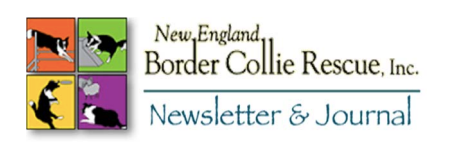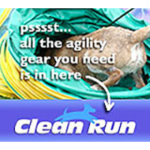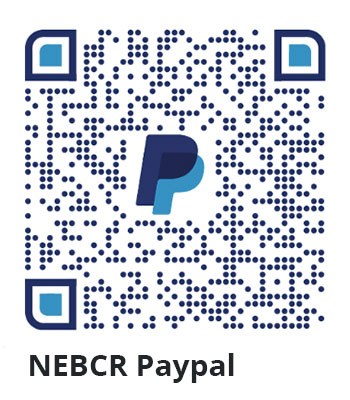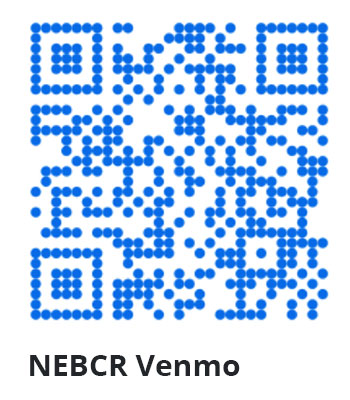Newsletter & Journal 2.1
VOLUME II NUMBER 1
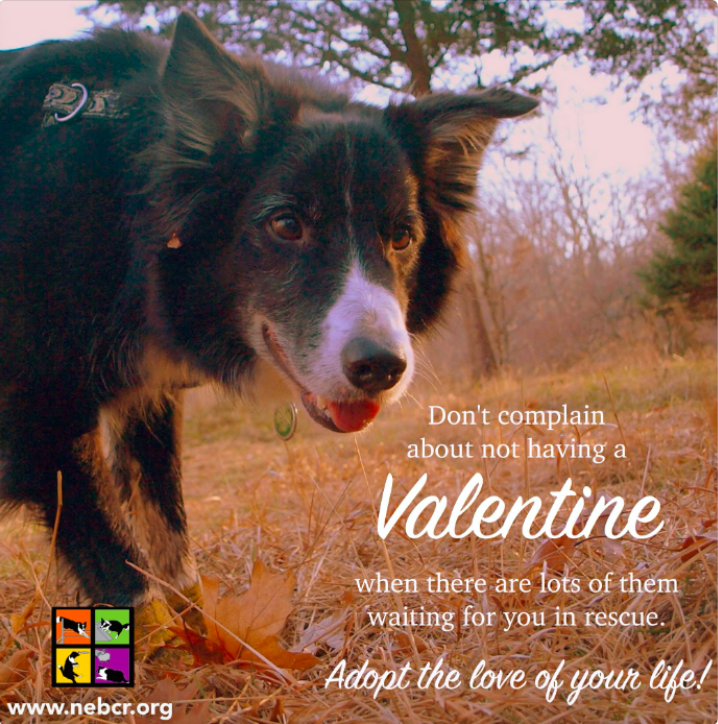
Co-Presidents: Bea Hamm & Sarah Hepburn
Treasurer: Mo Clark
Secretary: Emily Wu
Board of Directors: Monique Fisher, Elise Gouge, Marie Hinds
Website: Rebeca Kerr & Monique Fisher
Editors: Bea Hamm & Rebeca Kerr
Please send your content and pictures to us at: [email protected]
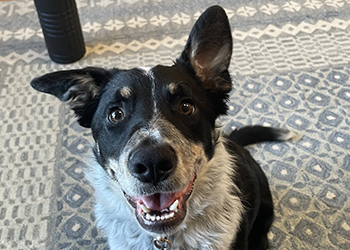
Featured:
Archie has been in rescue for a little while still waiting for his forever home.
You’ll find his full bio here.
Introducing Committee Member Donna Ciarlante
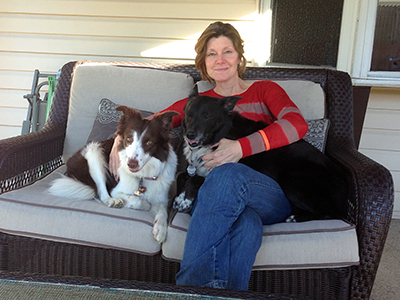
I knew that I would volunteer one day after the adoption of our first NEBCR dog many years ago. At that time, I had kids at home and was fostering expectant mama cats for a local shelter. After adopting our 3rd NEBCR dog about 8 years ago, it was time to jump onboard.
I’m so glad that I did! I’ve met many kind and wonderful folks through NEBCR and I look forward to many more years of volunteering.
Mostly, I volunteer as the applications coordinator but I also transport, evaluate, and foster occasionally. Being there for a dog in need is hugely rewarding. It is also pretty awesome to be a small part of every adoption through the applications committee. We really have an amazing community of volunteers, adopters and supporters!
My journey to volunteering for NEBCR began a long time ago. I’ve had a love of herding breeds from my earliest memories. My childhood dog was a collie/shepherd mix and she was the best dog! My first dog as an adult was a border collie mix (mostly border collie) that was found as a stray pup. That fuzzy pup grew into a stunning black and white rough coated boy and the most incredible dog. He was the dog that convinced me that I am a border collie person.
Our first NEBCR dog was an 11 yr old spunky boy named Connor. He was another perfect dog and we couldn’t fathom anyone giving him up. He became a registered therapy and READ dog and we enjoyed many years of hospital and nursing home visitations as well as being one of two READ dogs for the local children’s library.
Connor was a great mentor for our second NEBCR dog, Lil, a beautiful red and white girl who was part of the Spraker’s rescue. Lil came as fearful and lacking both social skills and confidence. Lil is my inspiration for learning everything dog and 10 years later, I am still reading and taking classes. Lil has made me a life long learner.
Adoptee number 3 is Jax, a then 2 yr old high energy, super smart, handsome boy who also turned out to be deaf. Genetic testing indicated early onset deafness. Jax has taught me the importance of body language and non verbal communication. We have our own language which is a mix of American Sign Language and made up gestures. He loves learning new tricks, is always up for anything and is the most enthusiastic tugger! He’s my velcro dog, copilot and right hand.
I am grateful to NEBCR for my dogs and for giving me an opportunity to help other border collies find their people. I live in Connecticut with my husband, three border collies (including Lil age 11 and Jax age 10), two cats, sheep, a rabbit and NEBCR foster Finnegan. I love wildflowers, hiking and reading. When there is any time to spare, I work on my long term project of replacing our invasive plants with native plants .
It’s a very good life!
That’s What We Do!
Rescue:
NEBCR, now 24 years old has placed hundreds of dogs over the years. We find loving homes for dogs that owners can no longer afford to care for, strays, the owners have lost their home or a death in the family. Often they may be passed on to us from an overcrowded shelter where euthanasia is a strong possibility.
Rehabilitate:
Nearly every dog that enters our rescue requires medical attention and/or behavioral modification. Each dog is processed individually receiving vaccines, parasite treatment, microchipped, spay/neuter surgery, heartworm check and treatment if needed. Foster homes also provide basic training while in foster care.
Rehome:
Our amazing foster homes are committed to finding the best match for their foster. While fostering they get to know what it will take to make their fosters a successful placement. Our goal is to match energy and interests that makes the new family and dog both happy.
We love getting updates on the their adventures and developing connection with the new family. If you’re looking to add to your family check out our available dogs here: www.nebcr.org
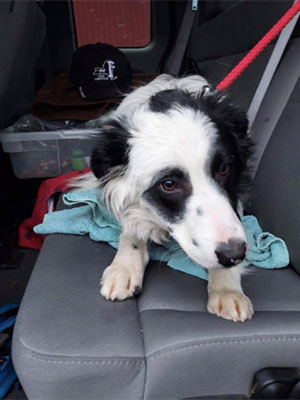
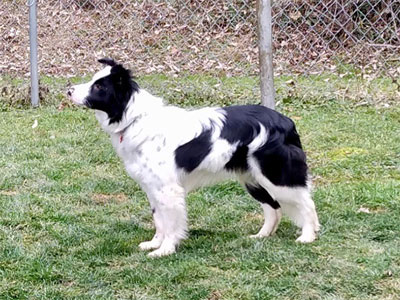
Year in Review 2023
This video celebrates the Border Collies that made their way to NEBCR in 2023. Many found their forever home, a few are still waiting and 3 are in hospice care. Enjoy!
ASK THE VET:
Vestibular disease
by Dr Sarah Hepburn
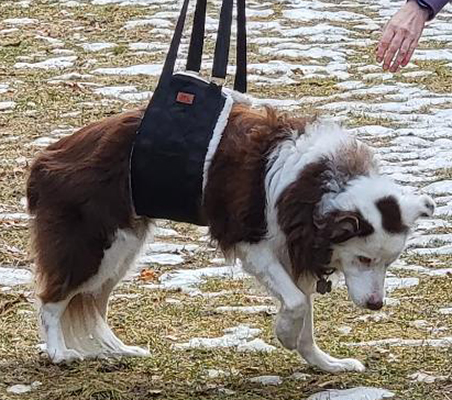
Vestibular disease in dogs is a condition that affects their vestibular system which is responsible for maintaining balance and spatial orientation. Disorders of the vestibular system can occur suddenly and cause disorientation, loss of coordination, and other alarming symptoms.
The vestibular system comprises the inner ear and brain structures that process information related to balance and spatial awareness. When this system malfunctions, dogs have an experience similar to vertigo in humans. They may develop a range of symptoms including head tilt, stumbling, circling, and involuntary eye movements known as nystagmus. These signs can be distressing for both dogs and their owners.
There are two main types of vestibular disease in dogs: peripheral and central. Peripheral vestibular disease is more common and may arise spontaneously without an underlying cause (idiopathic) or be due to issues in the inner ear, such as infections, inflammation, or the presence of tumors. On the other hand, central vestibular disease involves problems within the brain itself, potentially caused by tumors or strokes.
Diagnosing vestibular disease typically involves a thorough examination by a veterinarian. Blood tests, imaging studies like X-rays or MRIs, and assessments of eye movements may be conducted to determine the underlying cause. Fortunately, many cases of peripheral vestibular disease resolve on their own with supportive care, such as anti-nausea medications and a quiet, comfortable environment.
For central vestibular disease or cases with severe symptoms, more intensive treatments may be necessary. In these instances, addressing the underlying cause becomes crucial, and interventions like surgery or radiation therapy may be recommended.
Pet owners often worry about the long-term impact of vestibular disease on their furry companions. The good news is that many dogs show significant improvement within a few days to weeks. While some may retain a slight head tilt, they can generally regain their balance and lead normal, happy lives.
Vestibular disease in dogs can be a frightening experience for both pets and their owners. However, with prompt veterinary attention and appropriate care, many dogs can overcome this condition and return to their playful selves. If you notice any symptoms of vestibular disease in your dog, seeking professional advice is crucial for a timely and effective resolution.
Trainer’s Corner:
How to Add Gorgeous Color to Dreary Winter Days
by Elise Gouge, CPDT, CABC Certified Behavior Consultant & Trainer

That’s a weird title for an article, right? Well, I’m not talking about dying your dog’s coat purple (although I’ve done that before) and I’m not talking about doing pawprint paintings with your dog (but if you want to learn to do that, we can teach you). No, I’m talking about adding metaphorical color zest to the doldrums of this gray, brown, lackluster time of year. How do we do that? Keep reading!
Human and Puppy Both Feeling Enriched
After I meet with clients for our initial consultation, I often get texts or emails where the owner comments how tired their dog is when they get home. They haven’t exercised, they haven’t played fetch or tug, they’ve just sat in my office for two hours while the grown-ups talked.

While we talk, I am also consistently doling out puzzles and riddles for the dogs. It allows the dog a way to tell me their own tale. By showing me how they interact with novel puzzles, which ones they like, which ones scare them, which ones they give up on, which ones make them bark with frustration, they are telling me information about their confidence, intelligence, bravery, life experience, ability to tolerate frustration and solve problems, and what puts a sparkle in their eye! I use this as a diagnostic tool but there’s a practical aspect to it also. I want to keep these dogs busy so I can talk to their owner. If the dog is barking or being frantic, it stops us from using our time productively and results in frustration.
This is what I do with dog bowls…graffiti
This isn’t unlike what happens at home with your dog. You have two choices. You can rotate through a bunch of puzzles and riddles to keep your dog engaged or you can wait until boredom pushes your dog to annoy you with barking, chewing things up, running away or other unwanted behaviors.
So, we’re talking about enrichment here. Enrichment. Making your dog’s life richer, more colorful, more satiating, more robust and just…more. These days, it’s so easy to provide inexpensive and effective enrichment for your dog. There are books about it, videos and podcasts, and old-fashioned articles like this one. I’m going to give you a list of enriching activities you can do to make life a pure delight for your dog which means that you also get the benefit of all that delight!

Lose the food bowl. Feed your dog without a food bowl. Scatter the food in the yard or house and have them find it. Put in an Amazon box, tape it up and let them rip through it to find their kibble. Train them and reward them with handfuls of their dinner. Put it in a Kong or feeder toy and let them bang and lick it out. Sprinkle it in a cupcake tin, pour a little broth in each compartment, freeze it and let them figure out how to get it. Buy any one of the zillion feeder toys out there and use that for feeding (you can see my Amazon storefront for PBC’s favorites). Save your money and check out DIY ideas on websites like Bindi’s Bucket List. Make up your own ideas!
One very enriched doggo
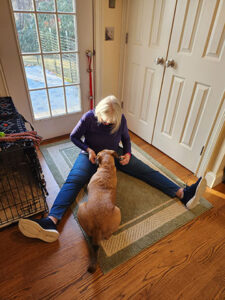
Play Hide & Seek or Find Me games. Wow, what a great way to
1) build recall
2) tire your dog out
3) strengthen your bond with your dog and 4) work on wait/stay! Put your dog in a wait or give him something to keep them busy for a minute (dab of peanut butter, small kibble scatter) and go hide somewhere in your house. Loudly call out your dog’s name and say “Find me!”. Watch your dog race around, up and down stairs, backwards and forwards, until they find you. Have a huge celebration when they find you and repeat. Each time, make your hiding place a little further away and a little harder. I practice this on hikes (hiding behind a tree), at home I go under the bed or into the shower or squeeze behind curtains or doors. It’s a blast!
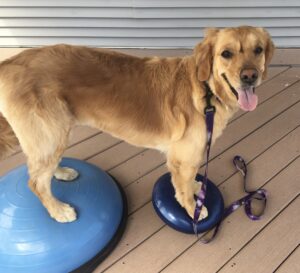
Play non-verbal impulse control games and watch your fall asleep before your very eyes. Doggy Zen and any variation of it will guarantee you hearing the sizzle and pop of their little brain cells vibrating from working hard. You might even see some smoke come out of their ears. In short, Zen is showing your dog something they want and WITHOUT WORDS doing a series of repetitions where every time they try to take it, you block them and every time they leave it alone you allow them visual access.
At some point, their fragile canine brain will look at you with some confusion as if to say, “what the heck? how do I get this stupid thing?!” and that’s the moment you mark with a clicker or a verbal marker like “yes” and deliver them a delicious nugget…that is better or equal to the thing they have left alone. They never get the thing they are doing zen with. When we use this in training eventually the thing they are zenning is a dead animal they want to roll in, or a tylenol, or something else we want them to leave alone forever and ever. OK, so here’s the cool thing. Your dog isn’t just learning this game where they leave something and then get a treat. They are learning that when they have big feels about something, if they leave it alone and check in with you instead, they will be richly rewarded. This can create absolutely incredible communication if you take it further than a winter enrichment game. Sue Ailsby, a wonderfully articulate writer and trainer, has written out several levels of zen in her Levels program.
You can check that out at https://sue-eh.ca/2020/07/21/tl-level-one/

Enrichment on equipment!
If you take 20 minutes to play these games with your dog every day, I would wager you’d be thrilled with what you saw. Your dog will be better behaved, happier, nicer to be with, I can promise you that 20 minutes of enrichment is way more fun than 20 minutes chasing your runaway dog around the neighborhood or picking up shreds of your favorite shoe! Winter is almost over so make the most of these gray days with colorful enrichment that will brighten your day in ways you’d never expect!
Always put on parental controls with computer enrichment
INTERESTED IN FOSTERING FOR NEBCR
The Process for Becoming a Foster Home
New foster families work with a rescue “supervisor”. The rescue supervisor has the ultimate responsibility for a dog, and makes all the major decisions relative to that dog, including authorizing anything out of the ordinary. They are responsible for screening potential adoptive homes, and for ultimately placing the dog, with input from the foster family.
Foster Home Responsibilities
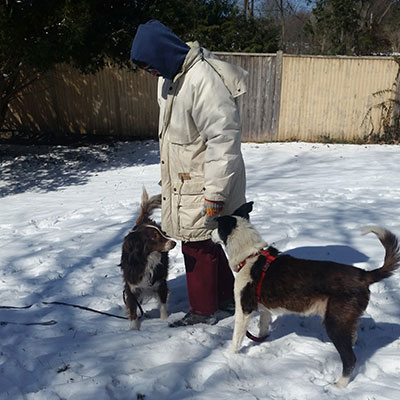
- Day-to-day care of your foster dog including their housing, feeding, and visits to the vet.
- Vet care requirements for all our rescue dogs.
- Working on house training, crate training, leash walking, and socialization where needed.
- Crating your foster dog at night and whenever you are not around to supervise him/her. (If you do not own a crate, one will be provided to you).
- Providing a secure environment where the dog cannot wander off (you will be provided an ID tag with NEBCR’s 800 number on it, which must be placed on the dog’s collar).
- Keeping records so that you may be reimbursed adequately for any out of pocket expenses for veterinary care and other expenses authorized by your supervisor.
- Communicating with your rescue supervisor on a regular basis with frequent updates on the status and progress of the dog.
- If determined to be necessary, attending an obedience class or consulting with a behaviorist.
- Working with the rescue supervisor to screen potential adoptive homes.
- Committing to providing a foster home for the dog for his entire term in rescue (barring unforeseen circumstances when a dog may have to be moved); anywhere from two weeks to many months.
Before You Make the Decision to Foster
- Understand that dogs often come into rescue with behavioral or health issues. Very few have any formal training, and many have not had much socialization with other dogs and/or people. There may be significant behavior issues to overcome such as: barking, marking, nipping, separation anxiety, shyness, or just a general lack of control and manners.
- Be sure that everyone in your household is committed to the idea of becoming a foster family.
- Be sure that child care providers or others who work in your home (and their parents, if they are under age) are aware of the commitment you are considering.
- Be sure that your own pets can adjust well to the addition of a foster dog to the family.
- Be sure that your own dogs get along with other dogs and are up to date on all their vaccinations.
You Will Not Be Alone
As a group we help one another. Volunteers are always available to answer questions, and offer guidance and support. We have volunteers that are professional trainers and behaviorists, some that are heavily involved in herding or dog sports, and many that have an enormous amount of experience with Border Collies as a breed, and with rescue. All of us work together to create a supportive environment where we share information, problem solve, and work towards a common goal – helping Border Collies in need.
* Please Note: we are not able to accept foster applications in the states of NH and RI at this time
